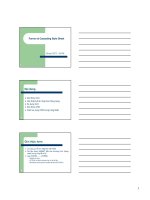Structural geology louie html
Bạn đang xem bản rút gọn của tài liệu. Xem và tải ngay bản đầy đủ của tài liệu tại đây (6.38 MB, 32 trang )
Lab 7 – Structural Geology
Chapter 10
Turn In:
Lab 6
Pre-Lab 7
EC 2
Handouts:
Quiz 6
Lab 7
Pre-Lab 8
Deformation
STRESS - direct pressure on the rock.
Compressive = shorten
Tensional = extension
STRAIN – when rock is stressed to the
point of failure = permanent
deformation.
/>
o
Beds are said to be dipping if they are oriented more than 0 from horizontal. (A cross-section sort of thing.)
Dip direction is the compass direction a marble would roll down the top of the individual bed. (Not the topography…)
(A map view sort of thing.)
Which compass direction do these beds
appear to be dipping?
(view looking approximately south)
W
Dip angle is the angle between horizontal and the flat face of the bed. (A cross-section sort of thing.)
How much do these beds appear to be dipping?
(view looking approximately south)
~35
o
W
o
Strike is the compass direction 90 from the dip direction, and is one direction in which beds are
laterally continuous.
(A map view sort of thing.)
Approximately which compass direction do these beds
(view looking approximately south)
~35
appear to be striking?
o
W
What does this look like
in map view?
Topo map review – find the valley and the ridges
Geol map stuff – find the strike and dip symbols
What are the map units relative to the picture?
TS2
Tertiary seds
A
*
20
(view looking southwest)
20
20
20
*
A’
N
TB1
Tertiary basalt 1
TB2
Tertiary basalt 2
What does this look like
in cross-section?
A
A’
Sketch only – NOT TO SCALE.
TS2
Tertiary seds
A
*
20
(view looking southwest)
20
20
20
*
A’
N
TB1
Tertiary basalt 1
TB2
Tertiary basalt 2
Quick Review: Identify the approximate dip direction, dip angle, and strike in the close
outcrop.
o
~??
The name of a landform is determined by how the beds dip…
A side effect is the relations of older and younger beds…
Folds and Block Diagrams
Anticline = oldest rocks
exposed in the center.
Syncline = youngest rocks
exposed in the center
Which directions are these beds dipping?
What are the relations of older and younger beds?
What are the names of the landforms?
Which way are the
beds dipping?
What are the
landforms?
www.geology.wisc.edu/courses/g112
CFW ‘07
Which feature has on overturned limb?
Which way is up on each limb?
web.uct.ac.za/depts/geolsci/dlr/laingsburg
www.geology.wisc.edu/courses/g112
Economic Look
Folds in alternating permeable and impermeable layers =
traps.
Can trap water, oil, etc…
/>
/>
Mt. Withrow
As the Rocky Mountains formed, the strata (rock
layers) of the Earth's crust were subjected to
stress which resulted in strain (folding).
Ridges = resistant sandstone
Valley = much less resistant shale.
Which way are the beds dipping?
Where is the nose?
What is the name of the structure?
Which way is it plunging?
Stress Types and Faults
Compressive Stress: causes shortening of the body on which it acts
Reverse or Thrust Fault: one rock gets pushed up over another.
Stress Types and Faults
Tensional Stress: Causes lengthening of the body on which it acts
Normal Fault: One rock slides down and away from another
Stress Types and Faults
Shear Stress: Causes shearing/tearing of the body on which it acts.
Strike-Slip Fault: One rock slides past another horizontally.
Quick
Quick Review
Review of
of Map
Map Views
Views ––
In
In each
each picture:
picture:
Which
Which units
units are
are oldest/youngest?
oldest/youngest?
Which
Which way
way are
are the
the beds
beds dipping?
dipping?
What
What structures
structures are
are present?
present?
Seismic Interpretation
Offshore Netherlands “F3” dataset courtesy of Paul deGroot of dGB
Open-source seismic software from OpendTect.org
Seismic Interpretation Lab
1) Strike and Dip
Put at least 10 strike-and-dip symbols on the horizontal section, consulting the vertical section as needed.
Identify and label a dome.
Identify and label a basin.
For the dome and basin you interpreted, explain the observations that support your interpretations. Point out the
observations noted on your sections:
Offshore Netherlands “F3” dataset courtesy of Paul deGroot of dGB
Open-source seismic software from OpendTect.org
Seismic Interpretation Lab Ex. 1 horizontal section
Seismic Interpretation Lab Ex. 1 vertical section
2) Plunging Fold
On the east side of the horizontal section is a plunging fold. Mark some strikes and dips around it, referring
to the vertical sections.
Interpret whether the fold is an anticline or syncline:
Interpret which direction the fold is plunging:
Label the fold on the horizontal section with the proper symbol at its axis.
Describe how your observations support your interpretations:
Seismic Interpretation Lab Ex. 2, 3 horizontal section









